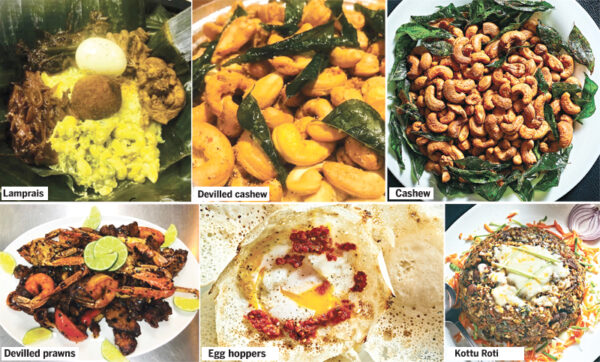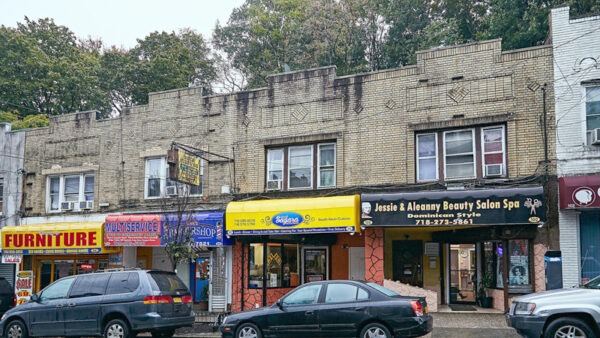
Source:Dailynews
Cashews fill the platter, dozens, maybe hundreds, curled like shrimp and dark from the pan, hot buttery mouthfuls strafed with salt and roasted red chilli powder. Curry leaves gleam, half-buried, fried and ready to snap, tasting of musk and charred lime.
This is a generous — and dangerous — start to dinner at Sagara, in Tompkinsville, Staten Island, by husband and wife Sagara and Anuradh Hewabajgamage, natives of Colombo, Sri Lanka. Eat too many cashews and you won’t make it through the meal to come, a parade of dishes based in part on recipes that Ms. Hewabajgamage learned by watching her grandmothers in the kitchen. (“The recipes weren’t written,” she said. “I had them in my head.”)
 Kurakkan Pittu |
Chief among them is lamprais, a specialty of the Dutch Burghers, mixed-race descendants of the colonists who started settling in Sri Lanka in the 17th century. In the dish’s name lies some of the tangled history of East and West: lamprais — whose pronunciation is close to “lump rise,” although some leave the P and S silent — comes from the Dutch portmanteau lomprijst, itself derived from lemper, sticky rice cakes with shredded meat inside, which the Dutch first encountered in Malaysia and Indonesia.
Here, what arrives is a grand parcel folded in banana leaves, with a little paper umbrella staked at one end, as if to say, “Let the party begin.” Inside is abundance: rice plumped on coconut milk and ghee and scented with rampe (pandan) and sera (lemongrass); more cashews, riled up by green chillies and given a menthol hit of fennel; ash plantains, deep-fried and evoking potatoes; eggplant gone dark and caramelly; and onions broken down with practically every spice in the larder, until they are half solid, half syrup.
Also tucked in is the curry of your choice, crowded with chicken heady from cardamom and cloves or nubs of mutton plush with fat. (The best part is the runoff, to be drunk by the spoonful.) And on top: a golden orb of a fish cutlet, and a wrinkled, paunchy oval that proves to be a deep-fried hard-boiled egg, crunchy coat giving way to the creamy yolk.
Elsewhere on the table might be hoppers, crepes of fermented rice flour curved like bowls, thick and spongy at the bottom with sides that get thinner and lacier as they reach up. And Kurakkan Pittu, small pillars of grated coconut and ragi (finger millet), to be knocked over and mixed with coconut milk and lunu miris, raw onion and chillies smashed in a mortar until the heat blooms, sweet and rank at once, brightened with the faintest trace of lime.
Here too is kottu, tangled scraps of roti tossed in a wok with vegetables and curry, calling to mind fried rice. One version gets a trickledown of melted mozzarella, Cheddar and blue cheese for a happy hint of funk.
Staten Island is home to more Sri Lankan immigrants than any other borough, with a population estimated at 5,000, more than five times what it was two decades ago when Hewabajgamage first came to New York. In his early years he took many jobs, driving a taxi and commuting as far as Philadelphia for work.
In 2007, he and his wife opened a restaurant called Vidutara, half a mile from where Sagara now stands, with Ms. Hewabajgamage running the kitchen. Then their third child was born and the economy went south, and they had to shutter within the year. Now they’re trying again, this time with the help of a veteran chef, Lalith Gunasekera.
Sagara doesn’t offer an immersive landscape, like Staten Island’s best-known Sri Lankan restaurant, Lakruwana: There are no great Buddha heads, no ritual devil masks. The dining room is unassuming, décor secondary to food, with walls a bland salmon pink and tables studiously cloaked in white with black overlays.
But the spirit is kind. On a recent evening, with the next ferry departure looming and Uber far in the distance, my group of offshore diners inquired hesitantly as to a local car service. Hewabajgamage sprang into action, ushering us into his S.U.V. and cheerfully reminiscing about his years as a taxi driver (“I was mugged!”).
There was no charge. We made it to the ferry with minutes to spare.
(New York Times)


Source:Dailynews
Beyond the Buddha statues by a cash register and two well-stocked grocery aisles lives a tiny kitchen at Sagara Food City. At first glance, the shop appears to be a neighbourhood market; but by Michelin Guide standards, the Tompkinsville Sri Lankan destination is actually a venerable one in the restaurant world. It has recently been called out for the second year in a row for its value and deliciousness with an award called “Bib Gourmand.”
Sagara Hewabajgamage smiles at the mention of the honour. He owns the eponymous restaurant with his wife, Anuradh, at 98 Victory Boulevard. In 2018, about a year after they opened, the New York Times raved about the humble place, then a bare-bones sit-down restaurant (See review below). While it attracted broader attention to Sagara Food City, it was the Michelin designation that truly blasted the storefront into a prestigious spotlight.
Phones continually ring now at Sagara from opening at 9 a.m. to closing at 9 p.m. Calls come from around the region for delivery. But the success and recognition did not come easily. And it is not taken for granted.
HOME ON STATEN ISLAND
The natives of Colombo, Sri Lanka, came to the United States in 1998, originally to Stamford, Conn. The childhood sweethearts researched that city and thought it would be easy to find jobs there. Both found work at a Donut Delight. But Anuradh was homesick — literally ill — and sorely missing the Isle of Gems.
So the next best thing beckoned — the Isle of Staaten, which has the highest concentration of Sri Lankans outside of Sri Lanka. “I couldn’t eat or drink,” Anuradh said of her time in Connecticut while she was expecting her first child.
Sagara had to carry her; she was so weak. He said of coming to the borough: “We have a lot of friends around here. We came here. And then she started to eat.”
Starting in 2002 in their new New York City hometown, Sagara worked part time at several jobs — delivering food, cleaning other businesses and as a clerk at an auto parts store — while Anuradh raised their three children. The couple decided to open a restaurant in 2007 in a spot near Cebra Avenue. They shut it down a year later and chalked it up to a learned entrepreneurial experience.
At Sagara Food City, business was great until April and May 2020. They temporarily closed the operation.
“All this time we had a very tough time. Groceries were moving fast — people were asking for delivery,” said Sagara. The proprietors subsequently switched up their format. The restaurant’s dining room proper turned into a mini Sri Lankan marketplace with a rich inventory of Ceylonese canned products, spices, teas and a refrigerated section with dozens of fresh herbs and vegetables. Sagara started to deliver locally and, as word spread, now to Upstate, New Jersey and Long Island.
“I move around,” said Sagara with a chuckle, adding, “We created a website for online orders, too.”
While customers call for groceries, the prepared food from the restaurant menu is the main draw at Sagara. The Hewabajgamages have branched into catering parties, another lucrative avenue for the business as the world opens back up.
One of the specialities of the house is a famous Sri Lankan dish called the lamprais. It is essentially a meal wrapped in a banana leaf — a sumptuous package of rice, caramelised eggplant and onions, fried plantains plus toothsome chilies and cashews. As sumptuous as are the other ingredients, the heart and soul of the lamprais are a single, deep-fried boiled egg, a sambol plus another protein — that could be mutton, chicken, pork, shrimp or kingfish.
Sagara Food City also sells curries, roti bread, so-called “deviled” dishes amped up with a thick chilli paste and Sri Lanka’s famed string hoppers. These are shredded patties that look like a patch of vermicelli noodles but made from a pancake-like crepe known as a hopper. These are so much in demand that Anuradh and the chef on duty, Pradeep Sanjeewa, make anywhere from 500 to 800 of them a day.
On a recent afternoon from the tiny confines of the kitchen, Sanjeewa tossed deep-fried kingfish cubes, prawns and calamari rings with green chillies and red onion slivers for to-go orders. Cashews boiled to softness on the stove while he pulled two massive bread loaves from the convection oven. The yeasty, savoury puffed out roasted paan is made with coconut oil. “We make 50 pieces a day,” said Anuradh.
In the front of the store, clerk Dinuka De Seram answers the continually ringing phone and packs up orders for pickup. He also acts as a guide to some of the produce in the fridge like the warty bitter melons and kan kun, leafy stalks also known as water spinach.
De Seram said of the kan kun, “It’s good for the scent and it’s very healthy.”
Anuradh shows off the expansive fresh items, teas, legumes and lentils. Afterwards, over the hum of refrigerator compressors, a radio played a song that sounded like it was broadcast from a monastery.
“Chanting . . . it’s important,” nodded Sagara.
“My kids, they want to hear that when they sleep. It’s very powerful, an invisible thing,” said Sagara. The music is soothing in these tumultuous times, said Sagara. And, as the business takes off, the background hum also is rather grounding.
The website, Sagarafoodcity.com, is still under construction although the store can be reached by phone call or text daily, except Monday — 1-718-285-4556. (SILive)
(Pamela Silvestri can be reached at silvestri@siadvance.com.)







